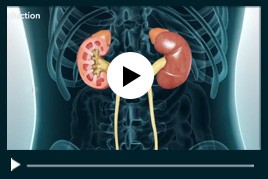Urinary Tract Infection UTI
Men's health :: Female Urology :: Paediatric Urology
Infections :: Urethral diverticulum :: Pelvic prolapse :: Urinary tract injuriesPregnancy & Urinary tract :: Urinary Incontinence :: Haematuria :: Cancer
A urinary tract infection (UTI) is the infection of the urinary system which mainly includes the kidneys, ureters, bladder, prostate (in men) and urethra. Urinary tract infections occur when bacteria develop in the urinary system.
Normal urine contains no bacteria (germs). Bacteria can get into the urine and the urinary tract from the skin around the rectum and genitals by traveling up the urethra into the bladder. Lower urinary tract infection or cystitis is the bacterial infection which is confined only to the bladder and the urethra.
Upper urinary tract infection or Pyelonephritis is a bacterial infection of the kidneys resulting from bacteria traveling from outside the body into the urethra to the bladder and finally to the kidneys through the ureters.
For women, the risk of having a UTI is greater than men. This is probably because of a shorter urethra, so it is easier for the bacteria to move up to bladder. Bacteria can get into the urinary tract following sexual intercourse or use of a diaphragm for birth control or after menopause.
The following risk factors increase the likelihood of having a urinary tract infection:
- Diabetes
- Advanced age
- Urinary retention (difficulty fully emptying the bladder)
- Use of urinary catheter to urinate
- Having urinary tract abnormalities that block the flow of urine
- Bowel incontinence (the loss of bowel control)
- Kidney stones
- Pregnancy
- Surgical procedures involving urinary tract
If you have a cystitis or bladder infection you may have an intense urge to pass urine, pain or burning sensation when urinating, and urine may look cloudy, bloody or have a foul smell.
If you have Pyelonephritis or kidney infection you may have fever with chills, flushed, reddened skin, pain in the back, nausea, and vomiting.
Your doctor will ask about urinary symptoms and then order the following tests if a UTI is suspected.
- Urine Test: A sample of urine is collected and analysed in a laboratory to determine if pus, red blood cells or bacteria are present.
- Ultrasound scan: An ultrasound scan is a non-invasive, painless scan done to see whether there are any abnormalities in your urinary tract, such as a narrow ureter or a bladder stone or kidney stone.
- DMSA Scan: A Di-mercaptosuccinic acid (DMSA) scan is a scan that is used to assess the state of the kidney. It is usually done six months after an acute UTI with unusual symptoms or after several recurring UTIs. During this procedure, DMSA will be injected into your body. The DMSA will start building up inside the kidneys after an hour. A series of pictures of your kidneys are then taken with a gamma camera. This scan takes about 30 minutes to complete.
- Micturating cystourethrogram (MCUG): This test is used to study the bladder and to check for Vesico-ureteral reflux. During MCUG, you are asked to lie on a bed with a urinary drainage catheter in place. A contrast agent is injected into the bladder through the catheter. An X-ray film will be taken as the contrast agent passes out of your bladder. If the X-ray film shows that the contrast agent is leaking back up the ureters to the kidneys from the bladder, then Vesico-ureteral reflux is diagnosed
Antibiotics are usually used to manage urinary tract infections. Depending on the type of infection present antibiotic therapy may be given either by mouth, IV or both. Your doctor may also prescribe medications to relieve burning pain and urge to urinate. Surgery may be needed if anatomical abnormalities in the urinary tract are causing UTI.

 Menu
Menu




